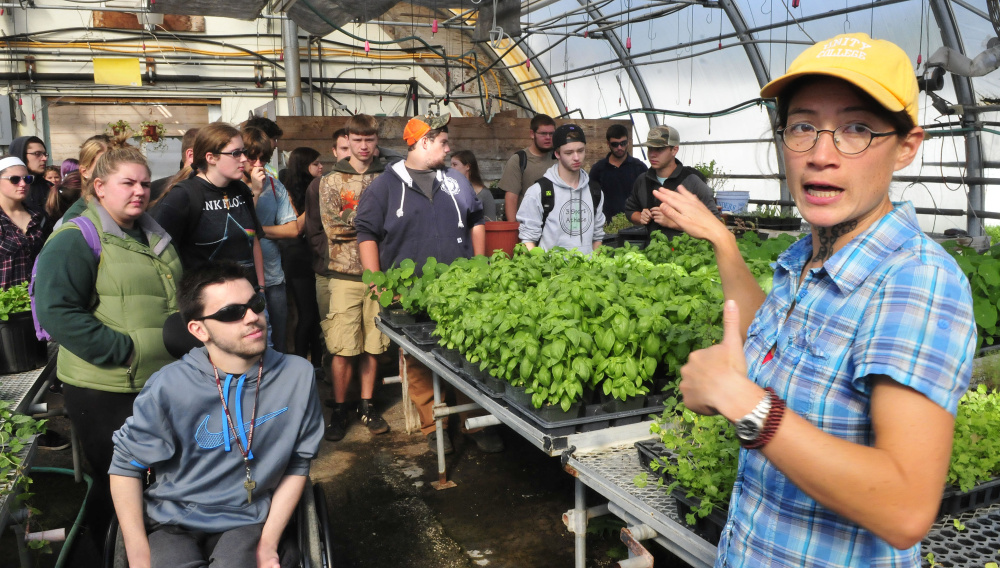THORNDIKE — Rows of spinach and carrots, a garden teeming with leafy greens and a field of pink, red and yellow flowers are among the first things one sees at the new McKay Farm and Research Station.
The greenhouse operation, formerly Half Moon Gardens, was donated to Unity College in 2013 and has taken on a new life as part of the school over the last two years.
“I’m hoping this will become an important part of your experience here at Unity College,” professor Mary Bulan, the director of the operation, told a group of about 50 freshmen on a recent weekday morning as they toured the greenhouses during an orientation class, the Unity Experience.
The greenhouse operation is the second-largest gift in the college’s 50-year history and is valued at $1.2 million, including five years’ worth of financial support from donors Isabel McKay and Rick Thompson.
The couple grew plants and vegetable seedlings and sold farm and livestock supplies for eight years before deciding to donate the 13-acre property, which includes five greenhouses and a hoop house.
‘IT SEEMED LIKE A GOOD FIT’
The decision came after Thompson’s father died and the couple re-evaluated their lives, McKay said.
They also have a farm, Stantial Brook Farm in Brooks, and the management of both the farm and greenhouse was too time-consuming, she said.
“It seemed like a good fit,” McKay said of their decision to donate the land and greenhouses. “I wanted to retire and I didn’t want to see the facilities sit here and rot.”
The school hired Bulan in July 2014 to run the research center, and the greenhouses and the garden have been back in operation since last year.
In the 2014-15 school year, the center produced 30,000 servings of vegetables for use in the dining hall at Unity College, and there are plans to increase production this year.
“My hope is that many of you will be able to get your hands dirty out here growing food for yourselves and your classmates and doing research,” Bulan told the students as they gathered outside the main greenhouse.
The center focuses on food production and student research. The farm is still largely open to the public – with a you-pick flower operation and seedlings for sale in the spring.
Bulan’s plans for the center include putting in an aquaponics system, testing seed varieties and partnering with local restaurants, farms and seed companies.
They already sell some of the food they produce to local stores and Regional School Unit 3.
“It’s a growing process,” said McKay, who remains involved in the operation and continues to visit and work with the center. “They still have a lot to learn about a commercial greenhouse operation.
It’s a complicated business. It’s not just growing food; it’s how to maintain the facility and the thermal solar panels and the economics of it. There’s a lot more to being sustainable than just growing food.”
‘NICE TO GET OUT OF THE CLASSROOM’
As the students walked through the greenhouses recently, they stopped to admire vines of cucumbers, pots of lettuce and basil and onions that had been picked and were waiting to be cleaned.
“It’s really nice to get out of the classroom and instead of reading about something, go see it,” said Alyssa Soucy, an 18-year-old from Cromwell, Connecticut, who plans to study conservation law enforcement.
In addition to Bulan, the greenhouse employs two people and is staffed by student volunteers, eight students who are in a work-study program and one intern. McKay said one of the biggest challenges for her in owning the greenhouse – which she originally purchased to compliment her farm – was managing employees, and she said she hopes students are able to learn how to be employers working at the greenhouse.
“I think the students can get a lot out of it,” said Sandy Willette, a greenhouse technician who has worked at the site for eight years, including when it was still Half Moon Gardens.
“It used to be full of plants – different varieties, too,” Willette said. “Instead of just one type of melon, there were four or five.”
In the fall the greenhouses are a little more sparse.
The busiest time of year is in May and June, when seedlings are for sale, according to Bulan.
And while production is not quite at full capacity yet, the staff at the center is looking forward to expanding in the coming seasons.
“This is something kids really need to learn,” Willette said. “Hopefully, we can reach out to other area schools and they can come do things here.”
McKay hopes the greenhouse operation will help the students integrate themselves into the local community and provide the community with organically grown food and flowers.
“It’s not just an economic exercise. It’s about integrating into the local community,” she said. “I think they’re getting there.”
A reception to celebrate at the greenhouses is set for 5:30 p.m. Saturday, beginning with music by the Dog Hounds.
At 6:30, McKay and college officials will make remarks, followed by student exhibitions, self-guided and guided garden tours, and food and beverages until 8 p.m.
Copy the Story Link
Send questions/comments to the editors.




Success. Please wait for the page to reload. If the page does not reload within 5 seconds, please refresh the page.
Enter your email and password to access comments.
Hi, to comment on stories you must . This profile is in addition to your subscription and website login.
Already have a commenting profile? .
Invalid username/password.
Please check your email to confirm and complete your registration.
Only subscribers are eligible to post comments. Please subscribe or login first for digital access. Here’s why.
Use the form below to reset your password. When you've submitted your account email, we will send an email with a reset code.